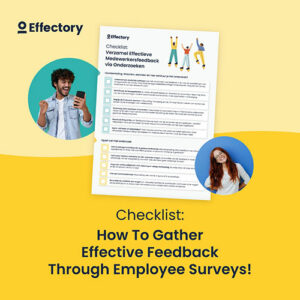It’s tempting to want to automatically collect feedback at every level of your organization, like asking employees after a meeting: “What did you think about it?” and “What did you think of everyone’s contribution?”
Employees are always eager to answer these feedback questions

360 feedback questions 24/7
That might sound great at first, but it’ll start to drive employees crazy and soon they’ll just stop giving feedback. You’ll have ruined it with them for the moment and they won’t want to face a questionnaire for a while.
How to Make the Most of the Feedback Landscape
Gathering feedback is very tricky. You shouldn’t ask your employees too many obvious questions too often, but asking good feedback questions is an art.
You need to set up your feedback dashboard so that the right question will automatically reach the right employee. And employees should want to answer the question because they can see where it’s leading and because it’s about a topic that’s really meaningful in the workplace.
This enables you to use different types of surveys without bothering your employees unnecessarily bothered, so their answers are valuable to the organization.
How to gather feedback from your employees
The definitive checklist for creating your employee engagement survey.
DownloadAsk New Employees Feedback Questions about Their New Jobs
Take onboarding. New employees are often full of expectations and are very much involved. This is the first time they’ve come into contact with all the different aspects of the organization and they often have an opinion on what they’ve discovered. And they want to share it, so they’re looking for an opportunity to do so. They’re also constantly talking about the new job to their friends, who are always asking them “So how’s it going at your new place?”
This means you can learn a lot about your organization; for example, by contacting these employees after three months and asking questions like “Have you been made to feel welcome?” “Have you got all the resources you need to do your job?” “What about the social side of things?” “Do you feel at home here?”
Best 360 Feedback Questions Allow Departing Employees to Vent
.Departing employees often want to have their say as well. They are often people who have put heart and soul into their jobs for years and when they leave, they actually want to say why. “This is the reason I left, I would have stayed if you’d done this, and if I want to share something, this is it.”
In many organizations, an HRM consultant or a manager is responsible for conducting such an exit interview. This doesn’t always happen in an ideal atmosphere, because their manager may also be upset that the employee is leaving and the resulting shortage of people means there is often little time for this conversation. As a result, organizations often do not get the most out of it.
However, if your questionnaire specifically asks why they are leaving, how they could have been retained and their most important tips for the organization, then you can collect this valuable information in a structured way. You can then use it for further analysis to prevent employees from leaving too quickly. You will also have a better basis for the exit interview, so it has more depth.
Be Flexible with Overarching Surveys
Every organization wants to get job satisfaction feedback from all employees every year or every two years, but you don’t have to do it all at once. You can give departments and teams the freedom to choose the time themselves.
Some of the work experience questions are addressed to everyone in the organization, but you can also give teams and departments room to ask their own questions about topics specific to them.
This ensures that you collect feedback from all employees while the questions are as close as possible to their individual experience. As a result, you learn more about their team, the department and the organization as a whole.
This means you get generic information for the entire organization in terms of job satisfaction, while each team can choose both timing and additional questions. This will enable you to combine centralized and decentralized surveys perfectly to make the feedback you get even more valuable.
Employee experience in 3 easy steps
Learn the best ways to improve the employee experience in your organization with these 3 easy-to-follow tips! Get your copy today!
Download: employee experience tipsCreate a Safety Net
Of course, you want to ensure that all employees are asked for feedback in a timely manner. So, if some teams haven’t taken any action after a certain period of time, you can create a safety net by automatically sending the central questionnaire to anyone who has not yet provided any feedback.
This ensures that teams have maximum freedom of choice to put their own spin on the survey, while you also achieve your survey goals at an organizational level.
Provide Employees with Personal Feedback
If you also give each employee personal feedback that links to feedback from their colleagues, you make sure that the results are as motivating as possible.
This digital individual report shows exactly how the employee views at each point of the questionnaire. So each individual employee will see exactly how enthusiastic they are, their relationship with the manager and the team spirit that is perceived.
And if any action is required because an employee scores low – absolutely or relatively – then they are also made aware of this.
For example, if employees are negative about their work, they are given tips on what they can do to change things. And this is completely confidential; this report only goes to the employee in question.
Check your organizational pulse
You can also do further surveys by team and by theme on topics such as pressure at work, communication or management.
You can respond quickly to current issues with a pulse survey. If lots of things are happening within the organization, this will help you to keep your finger on the pulse and intervene in time if necessary.
Feedback as an Outlet
If you gather feedback professionally, don’t bother employees unnecessarily, interpret the results well and then translate them into action, feedback can be incredibly stimulating for the development of organizations, teams and employees. Employees feel valued because their ideas are listened to and something is really done about them.
What’s more, if you respond to what employees automatically want to say by giving them the outlet they are looking for, then you will have a constant update on exactly what you need to know to improve your organization.
The Art of Feedback Questions: Eight Golden Rules
Questionnaires are only useful if they make employees feel that they are really being heard. This is what we’ve learned over the last twenty years about creating employee surveys:
1. Don’t ask questions to satisfy your curiosity
You shouldn’t ask questions if you don’t intend to do anything with the answers. Feedback should ideally be implemented immediately and be about topics that are also relevant to employees. The answers will give you specific indications on how to get new employees off to a flying start, prevent premature employee turnover and encourage employee development.
2. Choose the perfect moment
A good questionnaire is aligned with the employee journey. If you have a new joiner, for example, do an onboarding survey: ask if they have been able to find the right information and are getting sufficient guidance.
3. Approach exactly the right people
If a change will primarily have local consequences, it makes sense to limit your survey group to the departments that are affected. You can stay sharp by responding immediately to current developments with pulse surveys.
4. Protect the privacy of respondents
Good reports are anonymous and cannot be traced back to individuals. So you shouldn’t report scores based on personal characteristics such as age and gender and years of employment if there are only ten people working in a given department.
5. Be prepared to really listen
Sometimes it’s better not to pin respondents down too much, otherwise you never hear anything new. A good questionnaire not only looks for assessment figures but also asks open questions.
6. Keep questionnaires as short as possible
Tempting as it is to get the most out of a feedback opportunity, you usually end up with the opposite. A good questionnaire is short and to the point, focusing on exactly what you want to know. If the figures show something striking, you can always zoom in more on a sub-theme in a follow-up survey.
7. Do your research beforehand
A good consultant talks to relevant contacts within an organization before an employee survey. Which departments have recently had major shifts? How are things with pressure at work? What matters really need attention? After all, every organization is unique.
8. Use benchmarks to properly interpret results
Benchmarks are also important. As Effectory continuously surveys employees across organizations, industries and countries, we can put every survey result in the right context. For example, we know in which countries employee enthusiasm is lower. So if an organization scores low, the benchmark can tell us immediately whether that is a cause for concern.
Data-Driven Solutions
You can use people analytics to dive deeper into employee survey data. This will give you an insight into things like how managers are valued by department, the work pressure experienced by age group, or resilience to staff turnover based on the number of years in service.
Understanding how working conditions affect the organization can help prevent unwanted staff turnover. You can also identify drivers from high-performing teams and use that knowledge to improve the organization as a whole and determine data-driven solutions for specific organizational challenges.
Employee Engagement
Increase employee engagement through action-oriented feedback. Using a single platform, you can collect reliable data, analyze the results, and share insights.
view employee survey solution
